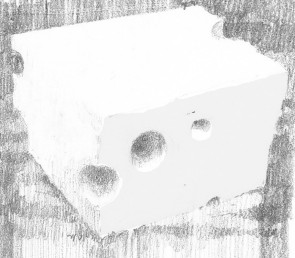Nil and Null
Absence versus Presence.
The equation,
M = E - e.sin(E),
which pertains to the so-called ‘anomalies’ of Keplerian orbits, has no variable for temperature.
This is because temperature is not found to affect an orbit, or an orbit to affect temperature. Orbits and temperature are disjoint. They do not interact. They are not incident. An orbit cannot be assigned a temperature, and temperatures do not have orbits.
One could say orbits and temperature are null to each other. Neither has any means to detect the other. Quite generally, equations null-ify irrelevant, non-incident variables simply by excluding them – and, let there be no doubt, they certainly do not do so by setting them to nil.
So it is with size and point. They are null to each other.
A point has no size - by this we do not mean to imply that a point's size is nil, or zero (zero is, after all, a size); we mean that the size is not there. It is absent. Size is simply not among a point's features. In fact a point has exactly one feature, and it is place, not size. A place is null with regard to size. One can no more assign a size to a point, than a point to a size.
This lack-of-size extends to the other elements.
The elements have exactly one quality each, and none of these is size.
As pure quality, they are null to quantity.
To make all this literally concrete, think of a lump of ... oh, say Gruyère cheese ... with mass m units, located at place P. The mass has a size. In fact, it has two—the size of the lump, in spatial units, and the size of the mass of the lump, in mass units (with this “pairing up”, we might just be heading into tensor territory). The relationship between these two sorts of size defines a property of Gruyère, namely its density, or mass per unit volume. But the place, or location, P, of the mass has no size, of any sort. We are not, in saying this, saying also that the mass is concentrated into point P, but we are saying (as in, ‘density’, above) that space and mass are somehow incident. So far, then, perhaps so ordinary—but do note the absence of a Gruyèrity variable.
But when the talk turns to “point masses”,
as often it does among physicists, we might be in difficulty: we are necessarily speaking then of a mass that is null with regard to spatial size. That is, it won't have a size, of any value whatsoever. Then, if we have two masses, one or both of the mass variables in Newton's equation for the inverse square law of gravitational attraction (S.I. units),
f = Gm1m2/r2 Newtons,
must – well, do what? Vanish? Go absent? Whatever else they may do, if they become null, they will not become nil.Assuming that a point mass, in spite of all these issues, may actually be greater than zero, and finite, say M kg, what is its density? As this is reckoned as mass per unit volume–that is, as M / V kg.m-3–surely it would in this instance be M / 0.0 = ∞ —a somewhat singular value. Oh, but wait! A point does not have a volume, of zero, or any other value at all ......
And if, even in the face of these difficulties, we are still prepared to countenance point-masses, are we prepared also to countenance line-masses, and plane-masses? I see nothing in principle to prevent us from doing so: if we can do it for one element, we can do it for all. Now, how big would they be?
Now, to sharpen our focus on these notions, and perhaps test them, let us consider another real, detected, non-abstract, non-hypothetical thing. Consider the neutrino.
We hear that a neutrino is probably massless. Do we take this to signify that it is null to mass, or that its mass is there, but nil? The distinction is probably important. I would guess that a particle with zero mass could be accelerated (at the actual, non-null rate of 0.0 m.s-2), and would feel gravity (to the actual, non-null tune of 0.0 N), but one without mass of any value couldn't, and wouldn't.
All this becomes academic in the face of a far more fundamental problem.
Caveat
Embedded in the arguments given in the panel to the left is a confusion which must eventually be properly addressed. It concerns the use of units, which are equal intervals by definition.
Their use is legitimate in equations – equations are, after all, engaged in establishing what is equal to what – but their use is not legitimate in axiomatic geometry, in which absolute measure is not preserved. There is no absolute equality, and hence there are no standard units.
The main implication of this is that many, if not all, so-called physical properties are not covered by geometry, and, if they are real, must have some other, non-geometric provenance.
